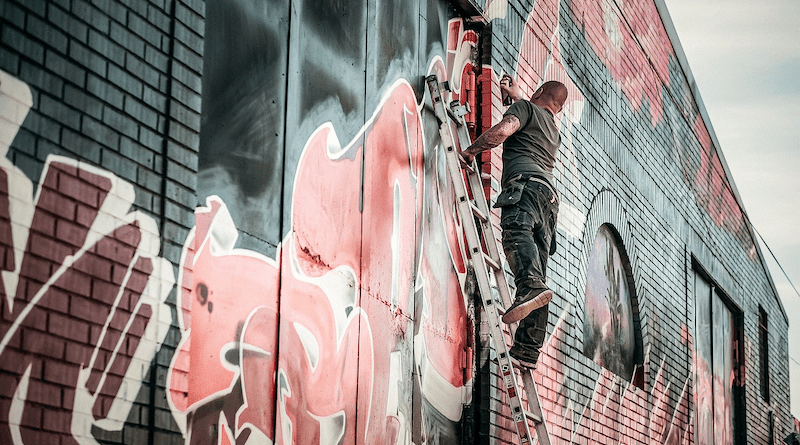Free Art Elbows Compulsions Of Commerce – OpEd
In London’s multicultural Brixton, a sizeable chunk of the 30-foot-tall Michelle Obama mural remains painted over as Dorrell Place becomes the place for graffiti artists/taggers/scrawlers to showcase their works of art. The homage to the former First Lady of the United States that first appeared on the side of the Marks & Spencer store in October 2018 was the creation of Dreph who made the advert in collaboration with Penguin Random House to promote the publication of Obama’s autobiography ‘Becoming,’ released on 13 November 2018.
Yet, by February 2021 the bottom half was painted over, and in the last couple of years the rest of the mural has dwindled to naught, almost symbolising the triumph of free art over the compulsions of commerce.
One of Dreph’s latest murals depicts Hassan Hajjaj who joined the burgeoning west London immigrant community. He felt very much a foreigner and many of the people he befriended were people who had had a similar journey and shared experiences of being the outsider. In this period, he made a lot of friends, many from the Caribbean, India and Pakistan, and says that they stuck together and looked after one another.
That said, strife is perhaps the most significant commonality in Street Art; and, it’s this strife that is symbolical of the processes even the resistance to populist trends and capitalist markets. In India, the Street Art scenario in financial capital Mumbai, in the absence of creative spunk even controlled by political entities and ‘permitted’ more often than growing organically as in the rest of the world, has failed to impress in comparison.
The two-month long St+art Urban Art Festival for Mumbai’s Sassoon Dock Art Project kickstarted on 11 November 2017 and ran until 30 December 2017 featuring an exhibition of structures and images of workers at India’s first wet dock and the oldest in Mumbai, situated in Colaba.
Pitched as having remained “a forgotten space of Mumbai, only home to the native Kolis living in a world of their own making,” the paintings depicted Kolis, a community that has grown organically even before the formation of Mumbai and live and work in the sea on the ‘other side’ of Colaba at Machchimar Nagar, having poor little to do with the trade at Sassoon Docks.
Glossing Over Details To Fact, Flavour
Sassoon Docks instead, is a commercial venture with docks where fish are cleaned, packed and exported to markets across the world. The Sassoon Docks provides livelihood for a range of communities from across India, apart from Kolis, who, at best, buy the fish locally for sale in markets in suburban Mumbai. The depiction in the Street Art seemed way off the mark and the local flavour and details to facts, sadly amiss.
In the same year, under an initiative of St+art Foundation, Asian Paints and Western Railways, a mural depicting Mahatma Gandhi exiting a train was created by Brazilian artist Eduardo Kobra at South Mumbai’s Churchgate Railway Station. A structural audit of the façade, even declared it fit during an inspection in 2018. However, a part of the cladding of the 81 ft x 54 ft mural broke loose during a cyclone in 2019 and fell on a 62-year-old pedestrian, killing him. The entire façade including the painting was ultimately brought down by the Western Railways.
“I have been painting nature, architecture, and local heritage on walls and in public spaces across the city,” says self-taught artist Sapna Patil who has been involved with painting real-life thematic images in and around Mumbai. Sapna is known for her painting of a seemingly-real train across an erstwhile paan-stained wall at Badhwar Park, in what was earlier a rather drab-looking passage, connecting South Mumbai’s Fourth Pasta Lane to Machchimar Nagar on the other side of the zone and passing through a Railway Colony.
Her detailed depiction of the ‘train’, complete with windows, bars, steps even handles is exquisite. “I wish I get more opportunities to paint about issues that affect people too,” she says. Sapna Patil’s works are an integral part of the Changing Colours of Colaba where public walls are given colourful make-overs through strategic paintings depicting the zone’s architecture and life.
The Badhwar Park ‘unsafe as ever’ passage that would lie in darkness, for over decades, even during the day, strewn with beggars, drug addicts and lumpen elements, has been transformed with ‘train’ and a surge of passers-by cannot help but stop by to take in the glory of the real-as-life painting. With scores stopping and shooting selfies in the zone against the backdrop of the ‘train’, the transformation of the stretch has been nothing short of magical.
On similar lines is the work of Chandigarh’s Sachita Aditi Sharma now based out of Himachal Pradesh in North India. After having painted “an entire village in Punjab to inspire villagers and show them a life that goes beyond drugs, walls in Goa even at venues in Hyderabad,” Sachita now works across India.
“I’ve cleaned little corners and walls in cities strewn with garbage and excreta and created works of art,” says Sachita who feels the entire ordeal of ‘getting permissions’ from local administration which is either inaccessible or simply not keen to comply, defeats the purpose of beautifying public zones.
Delhi-based artist and President Awardee Roop Chand feels the potential of artists being able to tap on public sentiment and educate masses has not been utilised to its fullest potential. Why, he feels that something as simple as propping up a social message on a brightly-painted waste-bin in a public place may make all the difference. “I have done it personally and seen it work. People actually stop, read and take in the message,” he says.
(This report is part of The Art Of Cause Project – a DraftCraft International initiative that documents Art Projects and Street Art campaigns that reach out, rectify and resolve strife, across the world)
Part 4 of 6 | To Be Continued

